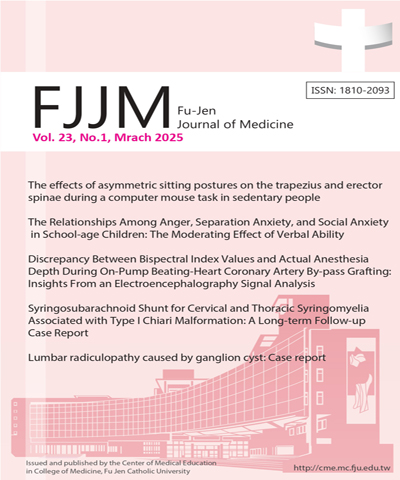
輔仁醫學期刊/Fu-Jen Journal of Medicine
輔仁大學醫學院,正常發行
選擇卷期
- 期刊
Background and purpose: A number of studies have examined the applicability of inertial sensors to human motion tracking and daily activities, but few have discussed their application to monitor exercises. This study focuses on leg motion tracking and the development of a simple kinematic based algorithm to classify leg motion data. Methods: A tele-monitoring system is proposed, using two inertial measurement units (IMU) are applied to each participant's knee and lateral malleolus to measure their open kinetic chain motion data. The motion classification was done through interpreting angular velocities simultaneously from two different IMUs. Results: There was a good sensitivity for knee flexion/extension (99.8%), hip flexion (95.8%) and knee internal rotation/external rotation (85.3%) and very low sensitivity for hip abduction/adduction (38.3%). However, the established algorithm owns good specificity for the four types of exercise, ranging from 80.5% to 99.8%. The causes of misinterpretation in this study were also discussed. Conclusions: The results show that properly affixed inertial measurement units and a suitable algorithm provide ideal wearable sensors for telerehabilitation.
- 期刊
Objective: Nuclear medical examination is to use agents labeled on unstable radioactive seeds. Then, these tracer agents are injected into the patient's body or absorbed orally. According to the characteristics of various tracer agents distributed to some specific tested organs, the extremely small amount of gamma rays emitted by these unstable nuclear seeds can be taken by radiological detection instrument for diagnosis. According to the previous literature and clinical studies, the quality of nuclear medicine is a relatively balanced role in the science of nuclear imaging. This research puts forward a hypothesis is: when radioactive tracer injection organisms, after a half-life, two half-life and after 24 hours, vascular endothelial cells in nuclear medicine retention, whether can produce damage effect. Methods: Experiments were conducted via the rat femoral vein injection dye agent Evans blue (EB), which was followed by the injection of the same concentration, a different dose (0.2 mCi, 1 mCi and 5 mCi) of radioisotope (free ^(99m)Tc) and then the EB in the tissue to measure the vascular permeability. Results: The longer the retention time, the vessels present a very slight leakage reaction. In addition, according to the colloid carbon leakage markers and the histomorphological experiments, the experimental results of vascular leakage showed that the experimental group showed a very small amount of colloid carbon leakage, and the red blood cells were only slightly infiltrated. However, the results showed no significant difference with the saline injection (control group). In terms of immunohistochemical staining, the presence of nitrotyrosine can serve as an indicator. The experimental results showed that the longer the residence time of nuclear drugs, the darker the color of nitrotyrosine. Taken together, these results suggest that the longer the exposure to radiation, the more NO is produced, or perhaps the endothelial cells are destroyed and the leakage increases. The conclusion of this study is that the excessive production of NO is involved in the vascular injury and leakage caused by radioactive nucleation seeds in vivo.
- 期刊
Spontaneous ureteral rupture is defined as nontraumatic ureteral leakage, and it is a rare urological disorder. Herein, we present a case of a patient who presented with fever, abdominal pain, and flank pain; the final diagnosis was confirmed with a computed tomography (CT) scan. The CT image showed left lower ureteral stone, which caused acute hydroureter and hydronephrosis with ureteral rupture, leading to fluid accumulation in the left perirenal and pararenal spaces (urinoma). The patient received left percutaneous nephrostomy, double-J stenting, and broad-spectrum antibiotic treatment, which resulted in a good outcome.
- 期刊
Polyethylene insert dislodgement has been most commonly reported following mobile-bearing and cruciate-retaining total knee replacements (TKRs). Only five cases of polyethylene insert dislodgement following a high-flex posterior-stabilized TKRs have been reported. We report a case of an 81-year-old male patient who presented with a traumatic dislodgement of insert that caused tibial component failure 7 years after prosthesis implantation. At the 1-year follow-up after surgical treatment, the range of motion of the left knee had fully recovered.
- 期刊
Isolated pure dorsal dislocation of the carpometacarpal (CMC) joint of the fifth finger is a rare hand injury. It is often difficult to diagnose and can easily be overlooked if clinicians are unaware of the clinical signs and subtle radiographic findings. Once neglected and left untreated, such injuries may result in long-term disabilities. Diagnosis is made both clinically and radiologically. A systemic approach should be adopted for the wrist radiograph involving standard anteroposterior, true lateral, and 30° pronated views. Treatments including closed reduction followed by casting, percutaneous pinning, and open reduction with internal fixation have been reported. This report presents an isolated pure dislocation of the fifth carpometacarpal joint that was successfully treated surgically. The anatomy, mechanism of injury, clinical features, diagnosis, and treatment options are discussed along with a review of the available literature.
- 期刊
Flexor tendon ruptures with closed distal radius fractures are rare. Little is known regarding the correlation between trauma and closed flexor carpi radius rupture. We report a case of a 68-year-old man who presented with a closed distal radius fracture. Intraoperatively, it was discovered that the flexor carpi radialis tendon had ruptured from the second metacarpal base. At the 16-month follow-up after surgical treatment, the range of motion of the left wrist had fully recovered.

